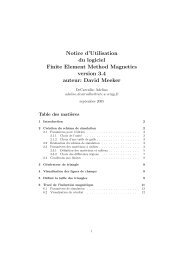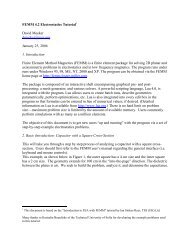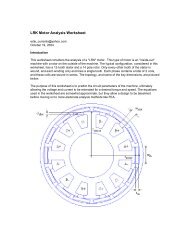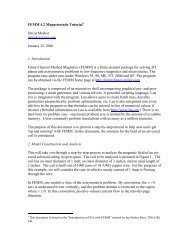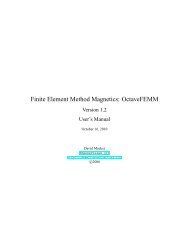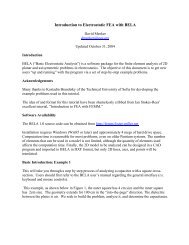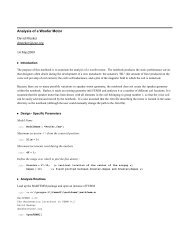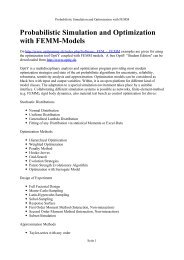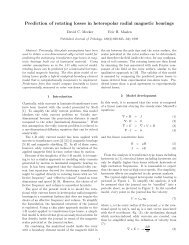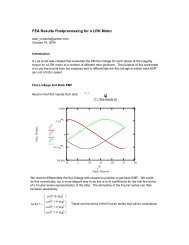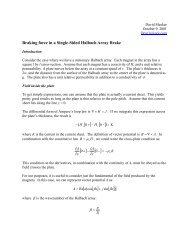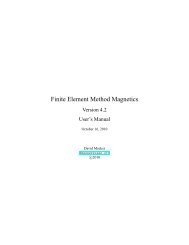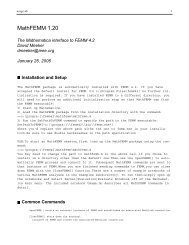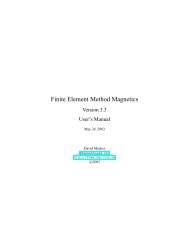1 Introduction - Finite Element Method Magnetics
1 Introduction - Finite Element Method Magnetics
1 Introduction - Finite Element Method Magnetics
You also want an ePaper? Increase the reach of your titles
YUMPU automatically turns print PDFs into web optimized ePapers that Google loves.
as discussed in Appendix A.3.3. Often, a periodic boundary is made up of several different<br />
line or arc segments. A different periodic condition must be defined for each section of the<br />
boundary, since each periodic BC can only be applied to a line or arc and a corresponding<br />
line or arc on the remote periodic boundary.<br />
• Antiperiodic The antiperiodic boundary condition is applied in a similar way as the periodic<br />
boundary condition, but its effect is to force two boundaries to be the negative of one<br />
another. This type of boundary is also typically used to reduce the domain which must be<br />
modeled, e.g. so that an electric machine might be modeled for the purposes of a finite<br />
element analysis with just one pole.<br />
3.7.3 Materials Properties<br />
The Block Property dialog box is used to specify the properties to be associated with block labels.<br />
The properties specified in this dialog have to do with the material that the block is composed<br />
of, as well as some attributes about how the material is put together (laminated). When a new<br />
material property is added or an existing property modified, the Block Property dialog pictured<br />
in Figure 10 appears.<br />
As with Point and Boundary properties, the first step is to choose a descriptive name for the<br />
material that is being described. Enter it in the Name edit box in lieu of “New Material.”<br />
Next decide whether the material will have a linear or nonlinear B-H curve by selecting the<br />
appropriate entry in the B-H Curve drop list.<br />
If Linear B-H Relationship was selected from the drop list, the next group of Linear<br />
Material Properties parameters will become enabled. FEMM allows you to specify different<br />
relative permeabilities in the vertical and horizontal directions (µx for the x- or horizontal direction,<br />
and µy for the y- or vertical direction).<br />
There are also boxes for φhx and φhy, which denote the hysteresis lag angle corresponding to<br />
each direction, to be used in cases in which linear material properties have been specified. A<br />
simple, but surprisingly effective, model for hysteresis in harmonic problems is to assume that<br />
hysteresis creates a constant phase lag between B and H that is independent of frequency. This is<br />
exactly the same as assuming that hysteresis loop has an elliptical shape. Since the hysteresis loop<br />
is not exactly elliptical, the perceived hysteresis angle will vary somewhat for different amplitudes<br />
of excitation. The hysteresis angle is typically not a parameter that appears on manufacturer’s<br />
data sheets; you have to identify it yourself from a frequency sweep on a toroidal coil with a core<br />
composed of the material of interest. For most laminated steels, the hysteresis angle lies between 0 o<br />
and 20 o [4]. This same reference also has a very good discussion of the derivation and application<br />
of the fixed phase lag model of hysteresis.<br />
If Nonlinear B-H Curve was selected from the drop list, the Nonlinear Material Properties<br />
parameter group becomes enabled. To enter in points on your B-H curve, hit the Edit B-H Curve<br />
button. When the button is pushed a dialog appears that allows you to enter in B-H data (see Figure<br />
11. The information to be entered in these dialogs is usually obtained by picking points off of<br />
manufacturer’s data sheets. For obvious reasons, you must enter the same number of points in the<br />
“B” (flux density) column as in the “H” (field intensity) column. To define a nonlinear material,<br />
you must enter at least three points, and you should enter ten or fifteen to get a good fit.<br />
After you are done entering in your B-H data points, it is a good idea to view the B-H curve to<br />
20



